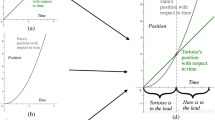Abstract
In preparation for an experiment to investigate the effectiveness of teaching conservation principles, we showed a large number of Grade 8 students two cubes of exactly the same size but with very different masses, and two other cubes of very different sizes but with the same mass (confirmed using scales). Students were then asked to predict the extent of the water level rise which would occur if each cube of each pair were to be placed in similar beakers of water and submerged. Initially almost all predicted on the basis of mass being the significant factor. A teaching sequence followed in which students interacted with different objects and measured water displacement. Following this they were retested on the same task and many now predicted that the rise of water level would depend only on the volume of the object being submerged. On the other hand some still stated that only mass would be important, and others believed a balance between the two would be the determining factor.
Similar content being viewed by others
References
Acredolo, C., & O'Connor, J. (1991). On the difficulty of detecting cognitive uncertainty.Human Development, 34, 204–223.
Baxter, J. (1989). Children's understanding of familiar astronomical events.International Journal of Science Education, 11, 502–513.
Brown, D. E. (1992). Using examples and analogies to remediate misconceptions in physics: factors influencing conceptual change.Journal of Research in Science Teaching, 29, 17–34.
Driver, R., Squires, A., Rushworth, P., & Wood-Robinson, V. (1994).Making sense of secondary science research into children's ideas. London: Routledge.
Fosnot, C. T. (1993). Rethinking science education: A defence of Piagetian constructivism.Journal of Research in Science Teaching, 30, 1189–1201.
Fruton, J.S. (1972).Molecules and life. Historical essays on the interplay of chemistry and biology, New York: Wiley-Science.
Hesse, J. J., & Anderson, C. W. (1992). Students' conceptions of chemical change.Journal of Research in Science Teaching, 29, 277–299.
Lawson, A. E. (1978). The development and validation of a classroom test of formal reasoning.Journal of Research in Science Teaching, 15, 11–24.
Novak, J. D., & Gowin, D. B. (1984).Learning how to learn. Cambridge: Cambridge University Press.
Osborne, R., & Freyberg, P. (1985).Learning in science. The implications of children's science. Auckland: Heinemann.
Pines, A. L., & West, L. H. T. (1986). Conceptual understanding and science learning: An interpretation of research within a sources-of-knowledge framework.Science Education, 70, 585–604.
Rowell, J. A. (1993). Developmentally-based insights for science teaching.Science & Education, 2, 111–136.
Rowell, J. A., & Dawson, C. J. (1981). Volume, conservation and instruction: A classroom based Solomon four group study of conflict.Journal of Research in Science Teaching, 18, 533–546.
Rowell, J. A., & Hoffmann P. J. (1975). Group tests for distinguishing formal from concrete thinkers.Journal of Research in Science Teaching, 12, 157–164.
Shayer, M., Adey, P., & Wylam, H. (1981). Group tests of cognitive development. Ideals and a realisation.Journal of Research in Science Teaching, 18, 157–168.
Villani, A. (1992). Conceptual change in science and science education.Science Education, 76, 223–237.
Author information
Authors and Affiliations
Corresponding author
Rights and permissions
About this article
Cite this article
Dawson, C.J., Rowell, J.A. Snapshots of uncertainty: A new tool for the indentification of students' conceptions of scientific phenomena. Research in Science Education 25, 89–100 (1995). https://doi.org/10.1007/BF02356462
Issue Date:
DOI: https://doi.org/10.1007/BF02356462




